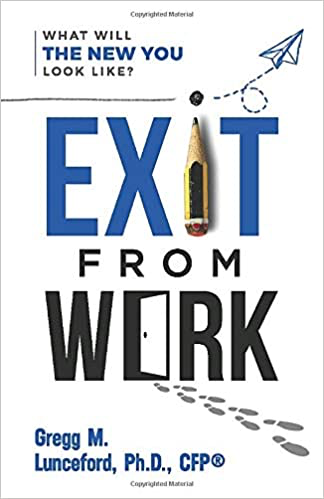Exit from Work
 I’m a baby boomer and assumed that after working for the same company for many years, that retirement would be relatively simple. I would use social security or a company pension to fund my retirement.
I’m a baby boomer and assumed that after working for the same company for many years, that retirement would be relatively simple. I would use social security or a company pension to fund my retirement.
I did a lot of reading and research casually preparing for my retirement and slowly came to realize that this would not be easy. While financially a challenge, mental and physical needs are just as important. All this has now changed due to the ongoing uncertainly of the pandemic.
But my work career, as a professional urban planner was eclectic, to say the least – nine job changes over thirty years, split between various government agencies at the state, regional and local levels, and the private sector for several engineering/development companies.
During this time, I also was in the US Army and Army National Guard, retiring after 38 years of service.
So, I was looking for additional guidance, knowing I wanted to “exit work” to something other than playing golf, traveling, and watching TV!
The book’s title Exit from Work – What Will the New You Look Like? and purpose – “explore exit from work in the 21st century to put it into greater context to help you develop a personal strategy for success” attracted my attention, hoping for more guidance for my retirement planning.
Note from Marc Miller – I asked David to review this book as a large portion of our generation will be forced into retirement by this pandemic. My own father was forced into retirement much earlier than planned and he never truly recovered.
Setting the Stage
Chapter 1 sets the framework for the later chapters, discussing how and why retirement has changed in the 21st century and discusses associated myths. Some are familiar myths – “my employer and social security will provide for my retirement,” “when to retire (65?!),” and “it’s easy to retire from a career or profession.” But now due to the uncertainty of the pandemic, these myths and perhaps the more “traditional” notion of retirement, have changed our thinking and planning forever. This discussion was important for me, being a “baby boomer”, in changing my retirement mindset to think and reflect on what is really important.
My Biggest Concern
As the author states, “Now, retirement can be a happy occasion as you shed unpleasant responsibilities, or it can be a sad transition as you let go of certain relationships, friends, colleagues, mentors, and others whose company you enjoy.” Examples are provided, one being “Thrivers” – those who still want to work but decide to do something meaningful, to contribute or pursue a passion – redefining their retirement.
This reinforced the need to change my retirement thinking. This also motivated me to move past my primary fear – that after leaving my job would I have the ambition, or sense of accomplishment to avoid boredom and loss of purpose?
Surprise
I expected a financial perspective given the author’s 25-year career in financial services. While this is obviously important (See Chapter 7), I was gratified the book provides just enough perspective about finances but delves into other issues for a successful exit. This again reinforced the needed reflection to find that purpose or passion after leaving the job.
My Takeaways
- “Remember, you are not the same person you were when you started at your current workplace”. This is sound advice because I have played many different roles during my career. The author urges reflection – think about what roles you enjoyed and have passion about when planning to leave work. This is a great tool that I had to learn and use to my advantage. I did this and wrote about all the jobs I’ve had – how I got them, why I left, and most importantly what I liked about each one. This has been invaluable as I continue to plan my exit.
- The author did a survey about retirement and what it means. Major findings included a perception that retirement meant one is old, there is age discrimination, and we see others failing in retirement – one can only play golf or travel so much. However, on the positive side: “Thrivers are also looking for ways to redesign their work to create work-life balance on their terms. They do not have to take on a new career. However, they must have activities they find meaningful that provide personal satisfaction such as mentoring or tutoring.” This validates my current retirement path, pursuing long lost interests, seeking service activities – volunteering, starting a blog about urban planning, and part-time work with the town where I live.
- “ ….people want something better in these extra decades of life, which is the gift most of us now potentially possess. Therefore, they won’t be exiting from their current work lives in any way similar to the way their parents or grandparents retired.” The author talks about choices that are available, given longer life expectancy, including taking time off (if affordable) to figure it out. I know a fellow retiree who did that, taking time to first walk 500 kilometers across Spain (Camino Frances) and then bike south to north in Great Britain. He figured it out – wrote a book about his Camino experience and is now a consultant, helping others to publish their books, He just finished another bike ride – 380 miles, the Great Alleghany Passage (GAP), from Pittsburg to Washington DC. This will be the subject of his next book!
- Two elements are needed to increase your exit – lifestyle activities that provide meaning and purpose and meaningful social relationships. While I cannot claim success yet, these have reduced my retirement fears – boredom and physical/mental deterioration. These elements are consistent with other subject leaders including Career Pivot (Marc Miller), Encore, and John Tarnoff. This is now more important than ever to get through the pandemic and uncertainty.
- A diagram is used to compare what aging used to be and what it is now, specifically there is a “Third Age” – after middle age, but before “Old Age”. These are the extra years from longer life expectancy. We can then use “Your life experiences have given you a better understanding of your likes and dislikes so you can more quickly choose jobs you enjoy versus taking on anything that feels like work. Remember this whole book is about exiting from work!” This is a guiding principle in my exit planning.
- To me, this is the essence of the book: “ When we talk about an exit from work, we have to talk about what stage, what types of exits are important, and what are the steps you need to go through in terms of an exit. “This includes taking risks (something I still struggle with), and not accepting what is normal or expected. It is then about reflecting, figuring it out, and then as someone said to me – just start!
Conclusion
 The book is concise, easy to read, and well organized, particularly the Action Takeaways at the end of each chapter. This is a to-do list, prompting actions.
The book is concise, easy to read, and well organized, particularly the Action Takeaways at the end of each chapter. This is a to-do list, prompting actions.
The book then is worth the time to read, providing practical action steps to prepare and execute for your exit.
It reinforced other thought leaders I follow while providing additional techniques and steps to modify my retirement path, specifically – take risks and action, leveraging my interests and passions, maximizing my additional years!
Like What Your Read? Get Career Pivot Insights
Do You Need Help With ...

Check out our Help Center where you have access to 14 different content portals.

